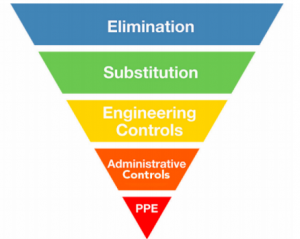Click Here for the Full PDF Version
The COVID-19 pandemic has certainly required business owners to be resourceful. With shortages in N95 masks, dust masks and hand sanitizer, many contractors have had to rely on the one thing that isn’t scarce, creativity. While many of these creative measures temporarily help us deal with shortages, they come with other challenges to construction employers. Take for example the DIY cloth mask. The Center for Disease Control (CDC) now recommends that members of the general public wear facial masks. Due to the shortage of masks, the CDC recommends members of the general public create their own. They have even created an instructional Homemade Cloth Face Covering webpage that describes how to build your own mask. I have heard of others repurposing neck warmers and scarfs as makeshift masks – some designs are quite interesting.
But it’s important to note that the CDC provides recommendations for the public and OSHA sets mandates for construction employers.
The CDC’s recommendations have triggered the adoption of DIY mask requirements in cities, counties, and by some of our customers (GC’s and Owners) who operate in these jurisdictions.
For construction employers, this creates some challenges. Construction employers need to carefully consider OSHA mandates when requiring employees to wear a mask. Before an employer can require an employee to put on PPE, the employer should, among other things:
- perform a hazard assessment
- consider other alternative options to protect employees
- identify and provide appropriate PPE for employees
- train employees in the use and care of PPE
- train employees how to clean and maintain PPE, including replacing worn or damaged PPE
- prepare a plan that is periodically reviewed, among other steps, including employee specific requirements
To be clear, OSHA has not yet issued guidance on the use of cloth mask.
Note: Employees can voluntarily wear manufactured or DIY masks during this pandemic but an employer requirement triggers a whole tsunami of OSHA requirements.
Note: Bandanas and DIY masks should not be treated as PPE.

This update was provided by Jerry Rivera, Safety Director for Washington DC NECA. Please contact Jerry with any safety related questions or training needs.
So, the question is: what can we do? OSHA Guidance on Preparing the Workplaces for COVID-19 gives employers some direction. For example, OSHA still advises:
- Social distancing
- promote frequent handwashing or
use of sanitizers - encourage respiratory etiquette
- frequent cleaning of break areas
- work in small crews
Source: https://www.safetyandhealthmagazine.com/articles/16790-the-hierarchy-of-controls

What construction employers should notice is that the initial recommendations for social distancing are still relevant today. There is great opportunity in refining the use of the Hierarchy of Controls such as Engineering and Administrative Controls. There are other resources available on the NECA Website for COVID-19. These resources range from safety toolbox talks to Guidance for Dealing with COVID-19 on construction sites.
In using the hierarchy of control, electrical contractors should be working in conjunction with owners and GC’s to ensure adequate engineering controls are available. These could be the use of high-efficiency air filters, increased ventilation and physical barriers where adequate.
For administrative controls, the adoption of a reduced workforce, rotating shifts, virtual meetings and emergency action plans for dealing with COVID-19 should also form part of our new way of doing business.
The American Society of Safety Professionals (ASSP) has also made some webinars related to COVID-19 available to the general public. One of particular interest is Legal Issues for Safety Professional by Adel Abrams.
In conclusion, while the CDC has been the governmental agency leading safety and health efforts for the general public, construction employers need to comply with OSHA updates.
Resources:
